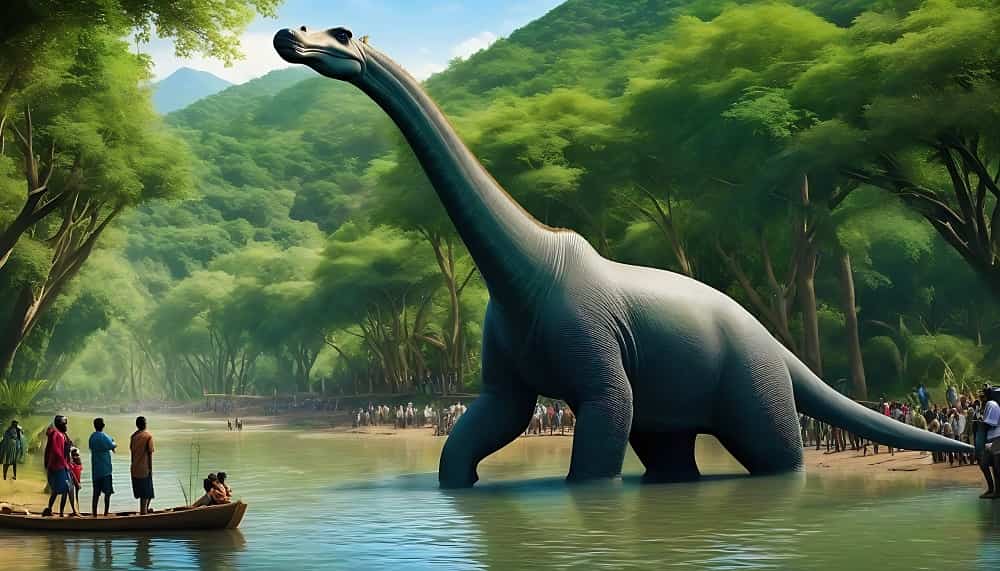Throughout the annals of scientific exploration, the unearthing of creatures once deemed extinct for centuries has been a recurring revelation. These revelations extend to the aquatic denizens that coexisted with dinosaurs eons ago. Among the enigmatic locales where such creatures may persist, the Congo Basin looms large. Nestled in the heart of Central Africa, this expansive, labyrinthine forest boasts an astonishing biodiversity—ten thousand tree and plant species, a thousand avian varieties, and four hundred animal species have garnered recognition. Yet, the staggering revelation surfaces: a mere 10 percent of this colossal forest has been charted by human endeavor. The remaining 90 percent cloaks itself in impenetrable density, posing formidable challenges to intrepid scientists. Within this clandestine realm, a tapestry of mysteries unfolds, with one elusive protagonist stealing the limelight—Mokele-mbembe.
In the heart of the Congo Basin, the term "Mokele-mbembe" resonates, translating to "one who stops the flow of rivers." For centuries, indigenous tribes have reported sightings of a mysterious creature, believed to be a fusion of an elephant and a dinosaur. This enigmatic being boasts a long neck, massive body, and sturdy legs, tailor-made for effortlessly feasting on tree leaves. The Congo tribe draws parallels with ancient "sauropods," dinosaurs from bygone eras.
Unique three-toed footprints, attributed to the elusive "Mokele-mbembe," punctuate the landscape of the Congo Basin. Descriptions of Mokele-mbembe vary, but it is often depicted as a large, long-necked reptilian creature, similar to a sauropod dinosaur. Some cryptozoologists and explorers have suggested that Mokele-mbembe might be a surviving dinosaur species, possibly a small population of sauropods that somehow escaped extinction.
Local Pygmies and intrepid explorers, spanning generations, share tales of encountering this creature along riverbanks and ponds. Allegedly sustaining itself on trees, plants, and fruits, the creature adeptly conceals itself beneath the water's depths for extended periods. Present-day sightings persist, fostering a belief among forest dwellers in the creature's tangible existence. Renowned researcher Roy Mackal embarked on a quest to unveil the mysteries of the Congo forest, patiently awaiting the creature for months. His breakthrough came with the discovery of fresh footprints, immortalized in a photograph, sparking excitement within the scientific community.
Mackal posited that these elusive beings inhabit the forbidding swamp area, a perilous expanse comparable to the size of New York. Venturing into the dense forest proves nearly impossible due to venomous creatures and serpents. The labyrinthine foliage requires hours to traverse, with no guarantee of a safe return. Astonishingly, forest inhabitants exhibited knowledge of the creature predating awareness of dinosaurs, identifying sauropod images as "mokele-mbembe."
In 1999, the Kabonga tribe claimed to have captured and slain the creature, while in the 1980s, Herman Regusters encountered footprints and distinctive sounds near Lake Tele. A 2016 documentary corroborated consistent descriptions of the creature among separate tribal communities. One tribe even shared an encounter, driving the creature away due to fear of an impending attack. Skeptics debate the feasibility of such a colossal creature in the Congo forest, citing oxygen and food requirements beyond Earth's capacity. However, some biologists argue that the region's abundant resources, coupled with elevated oxygen levels, make the existence of such a creature entirely plausible.
Even though the reports of Mokele-mbembe sightings come from local indigenous people and Western explorers, there is no scientific evidence to support the existence of such a creature. Many scientists consider the Mokele-mbembe legend to be more rooted in folklore and mythology rather than biological reality. Expeditions to search for Mokele-mbembe have been conducted, but none have provided conclusive evidence of its existence.















0 comments:
Post a Comment